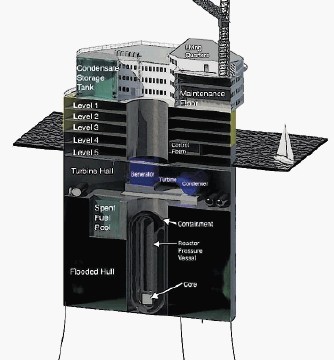
Researchers at MIT have cottoned to the potential value of oil and gas floating production systems design for offshore nuclear reactors.
They could be built and completed in a yard, towed to where they are required for power generation and then hooked up to an onshore grid via an interconnector.
And the concept that the MIT team is currently fielding is uncannily like the dumpy can-like design developed by Sevan of Norway for production and drilling purposes.
When an earthquake and tsunami struck the Fukushima Daiichi nuclear plant complex in 2011, neither the quake nor the inundation caused the ensuing contamination.
Rather, the MIT point out that it was the aftereffects – specifically, the lack of cooling for the reactor cores, due to a shutdown of all power at the station – that caused most of the harm.
And that is where the Sevan-style floating production system becomes attractive as a means of avoiding such consequences in the future, they claim.
Such floating plants would be designed to be automatically cooled by the surrounding seawater in a worst-case scenario, which would indefinitely prevent any melting of fuel rods, or escape of radioactive material.
The concept was presented late last month at the Small Modular Reactors Symposium, hosted by the American Society of Mechanical Engineers, by MIT professors Jacopo Buongiorno, Michael Golay, and Neil Todreas, along with others from MIT, the University of Wisconsin, and Chicago Bridge and Iron, a major nuclear plant and offshore platform construction company.
According to Buongiorno, such plants could be built in a shipyard, then towed to their destinations 8-12km (5-7 miles) offshore, where they would be tethered using systems well proven by the offshore oil and gas industry.
Using established designs minimises technological risks, says Buongiorno, who is an associate professor of nuclear science and engineering (NSE) at MIT.
Although the concept of a floating nuclear plant is not unique – Russia is building one now, on a barge moored at the shore – none have been located far enough offshore to be able to ride out a tsunami.
Buongiorno says the biggest selling point is “enhanced safety”. He argues that a nuclear power generation platform several miles offshore, moored in about 100m of water, would be unaffected by the motions of a tsunami; earthquakes would have no direct effect at all.
Meanwhile, the biggest issue that faces most nuclear plants under emergency conditions – overheating and potential meltdown, as happened at Fukushima, Chernobyl, and Three Mile Island – would apparently be virtually impossible at sea.
Buongiorno says: “It’s very close to the ocean, which is essentially an infinite heat sink, so it’s possible to do cooling passively, with no intervention. The reactor containment itself is essentially underwater.”
He lists several other advantages.
It is increasingly difficult and expensive to find suitable sites for new nuclear plants: They usually need to be next to an ocean, lake, or river to provide cooling water, but shorefront properties are highly desirable.
By contrast, sites offshore, out of sight of land, could be located adjacent to the population centres they would serve.
“The ocean is inexpensive real estate,” Buongiorno claims.
He reckons too that, at the end of a plant’s lifetime, decommissioning could be accomplished by towing it to a central facility, as is done now for redundant nuclear-powered naval vessels.
A further benefit claimed is that it will be easy to restore an offshore site.
The MIT team believes too that the heritage oil and gas approach could also help to address practical construction issues that have “tended to make new nuclear plants uneconomical”.
Like nuclear naval vessels, shipyard construction allows for better standardisation, and the all-steel design eliminates the use of concrete, which Buongiorno says is often responsible for construction delays and cost overruns.
There are no particular limits to the size of such plants . . . they could be anywhere from small, 50 megawatt plants to 1,000MW units, so matching today’s largest facilities.
Most operations would be similar to those of onshore plants, and the plant would be designed to meet all regulatory security requirements for terrestrial stations.
Project work has confirmed the feasibility of achieving this goal, including satisfaction of the extra concern of protection against underwater attack,” says colleague Todreas, the KEPCO professor of nuclear science and engineering and mechanical engineering.
They see a market for such plants in Asia, which has a combination of high tsunami risks and a rapidly growing need for new power sources.
“It would make a lot of sense for Japan,” he says, as well as places such as Indonesia, Chile, and Africa.
This concept has been well received in Japan with Toru Obara, a professor at the Research Laboratory for Nuclear Reactors at the Tokyo Institute of Technology, pronouncing it “technically very feasible.”
Recommended for you
